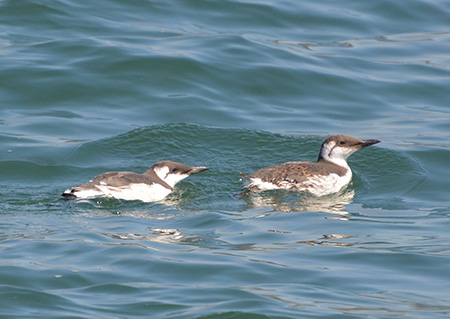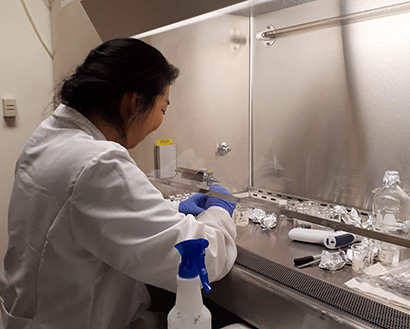Campus News
UCSC scientists find microplastics in Monterey Bay water, anchovies, and seabirds
Microparticles recovered from some seabirds exhibited estrogenic activity with potential to disrupt hormone functions.

The California anchovy or northern anchovy (Engraulis mordax) is a species of anchovy found in the Pacific Ocean, ranging from Mexico to British Columbia.


A study of microplastic pollution in Monterey Bay has found widespread occurrence of microplastics in the seawater and in the digestive tracts of anchovies and common murres, diving seabirds that feed on anchovies.
The study, accepted for publication in Environmental Pollution and available online, included testing microplastic particles recovered from the murres for estrogenic activity, which indicates the potential for hormone disrupting effects. The researchers found that all the murres examined had microparticles in their digestive tracts, and almost a quarter (23%) had particles that exhibited estrogenic activity.
“These tiny plastic particles are leaching substances that have the potential for hormonal disruption that can have cascading effects on reproductive and immune functions,” said senior author Myra Finkelstein, adjunct professor of environmental toxicology at UC Santa Cruz.
The study, led by UCSC graduate student Sami Michishita, sought to quantify the prevalence and composition of microparticles in Monterey Bay. The researchers found that 58% of anchovies and 100% of murres had microparticles (particles smaller than 5 millimeters) in their digestive tracts. Most of the particles (78%) were fibers, and more than half of the particles (57%) were identified as plastic using an optical technique called Raman spectroscopy.
The Raman spectroscopy was done in collaboration with Jenessa Gjeltema at UC Davis School of Veterinary Medicine, and testing for estrogenic activity was done in collaboration with the San Diego Zoo Wildlife Alliance.
“When you’re looking at tiny fibers under the microscope, you can’t always tell if it’s cotton or polyester, so we took that next step to determine what it was, and then took the further step of testing them for estrogenic activity,” Finkelstein said.
Seawater samples obtained from two intake systems—one in Santa Cruz and one in Moss Landing—contained about 2 microparticles per 1,000 liters. Anchovies would most likely accumulate the particles in their digestive systems because they feed by filtering tiny plankton from the seawater. As a significant component of the murres’ diets, the anchovies are probably a major source of the microplastics in the murres’ digestive systems.
Finkelstein has been studying the impact of plastic pollution on seabirds for years. Many seabirds consume relatively large pieces of plastic (“macroplastics”), mistaking it for food.
“One of the main problems with macroplastics is that they’re taking the place of food. With microplastics, a major concern is the toxic compounds that may be leaching out of it,” Finkelstein said.
Many of the chemicals associated with plastics are known as endocrine disrupting compounds because they can mimic hormones such as estrogen by binding to the hormone receptors in the body and disrupting physiological functions. In this study, the researchers did not try to determine how the murres or anchovies might be affected by the microplastics. That’s a harder question to study and one that Finkelstein’s lab is currently working to answer in collaboration with San Diego Zoo Wildlife Alliance.
“The next step is to see how this may be affecting the birds,” she said. “With microplastics, it seems we are finding them anywhere we look. But we need to do more work to find out what the biological impact is.”
Christopher Tubbs, associate director of reproductive sciences at San Diego Zoo Wildlife Alliance, said, “We know plastic debris, both large and small, in our oceans and waterways is an issue. This partnership between UCSC and San Diego Zoo Wildlife Alliance gives us the chance to dig into the reproductive consequences for seabirds when they consume microplastics. We believe this is the first time this type of estrogen-based assessment is being conducted for this type of widespread marine pollution.”
In addition to Michishita, Finkelstein, and Tubbs, the coauthors of the paper include Corinne Gibble at the California Department of Fish and Wildlife; Rachel Felton at the San Diego Zoo Wildlife Alliance; and Jenessa Gjeltema and Jackelyn Lang at UC Davis School of Veterinary Medicine. This work was supported by the Friends of the Seymour Center, UC Santa Cruz, and NorCal Society of Environmental Toxicology and Chemistry.